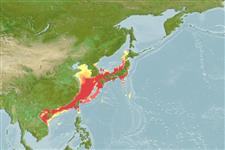Issue
Needs a taxonomic reference. Synonym of U. japonicus Randall, pers. comm.
Environment: milieu / climate zone / profondeur / distribution range
Écologie
marin récifal; profondeur 4 - 200 m (Ref. 28016), usually 4 - 90 m (Ref. 98481). Subtropical
Western Pacific: W Malaysia and the Philippines to South Korea and Peter the Great Bay, Russia (Ref. 98481). Records from more southern areas are probably mainly misidentifications of Upeneus guttatus (Day) or Upeneus sundaicus (Bleeker).
Taille / Poids / Âge
Maturité: Lm ? range ? - ? cm
Max length : 28.0 cm SL mâle / non sexé; (Ref. 107961); common length : 20.0 cm TL mâle / non sexé; (Ref. 5450); poids max. publié: 202.00 g (Ref. 107961)
Description synthétique
Clés d'identification | Morphologie | Morphométrie
Épines dorsales (Total) : 7. This species is distinguished by the following characters: D VII + 9; pectoral fins 13-15; gill rakers 6-8 + 18-21 = 24-28. Adult measurements as %SL: body depth at first dorsal-fin origin 21-25 and at anus 18-22; caudal-peduncle depth 8.0-11; maximum head depth 18-21 and through eye 15-17; head length 27-31; orbit length 6.1-8.2; upper jaw length 9.7-12; barbel length 18-23; caudal-fin length 25-29; anal-fin height 15-19; pelvic-fin length 19-23; pectoral-fin length 21-25; first dorsal-fin height 20-24 and second dorsal-fin height 15-19. Colouration: upper caudal-fin lobe in fresh fish with 3-4 red oblique bars while lower caudal-fin lobe almost entirely covered by a broad red stripe that becomes darker distally and is partially surrounded by a dark grey line and by a contrasting white fin margin and white lobe tip exteriorly; there are only weak indications of upper caudal fin lobe bars in preserved specimens with a dark pigmented zone remaining distally at the lower lobe; barbels are yellow; without lateral body stripes; head and body white or silvery ventrally and laterally, sometimes covered with red blotches, and uniformly red dorsally of lateral line; preserved fish are pale brown or brown (Ref. 98481).
Body shape (shape guide): fusiform / normal; Cross section: oval.
Widespread in sandy regions (Ref. 9137). Minimum depth from Ref. 098481.
Life cycle and mating behavior
Maturité | Reproduction | Frai | Œufs | Fécondité | Larves
Randall, J.E., M.L. Bauchot and P. Guézé, 1993. Upeneus japonicus (Houttuyn), a senior synonym of the Japanese goatfish U. bensasi (Temminck et Schlegel). Jap. J. Ichthyol. 40(3):301-305. (Ref. 10687)
Statut dans la liste rouge de l'IUCN (Ref. 130435: Version 2025-1)
Menace pour l'homme
Harmless
Utilisations par l'homme
Pêcheries: intérêt commercial mineur
Outils
Articles particuliers
Télécharger en XML
Sources Internet
Estimates based on models
Preferred temperature (Réf.
123201): 14 - 23.6, mean 19.2 °C (based on 134 cells).
Phylogenetic diversity index (Réf.
82804): PD
50 = 0.5000 [Uniqueness, from 0.5 = low to 2.0 = high].
Bayesian length-weight: a=0.01023 (0.00646 - 0.01622), b=3.11 (2.98 - 3.24), in cm total length, based on LWR estimates for this species & Genus-body shape (Ref.
93245).
Niveau trophique (Réf.
69278): 3.6 ±0.38 se; based on food items.
Résilience (Réf.
120179): Haut, temps minimum de doublement de population inférieur à 15 mois (K=0.4-0.8;).
Fishing Vulnerability (Ref.
59153): Low vulnerability (23 of 100).
🛈
Nutrients (Ref.
124155): Calcium = 49.6 [22.5, 113.9] mg/100g; Iron = 0.641 [0.292, 1.218] mg/100g; Protein = 18.6 [16.4, 21.0] %; Omega3 = 0.316 [0.170, 0.602] g/100g; Selenium = 16.9 [7.7, 34.5] μg/100g; VitaminA = 73.3 [20.9, 315.7] μg/100g; Zinc = 0.901 [0.536, 1.401] mg/100g (wet weight);
